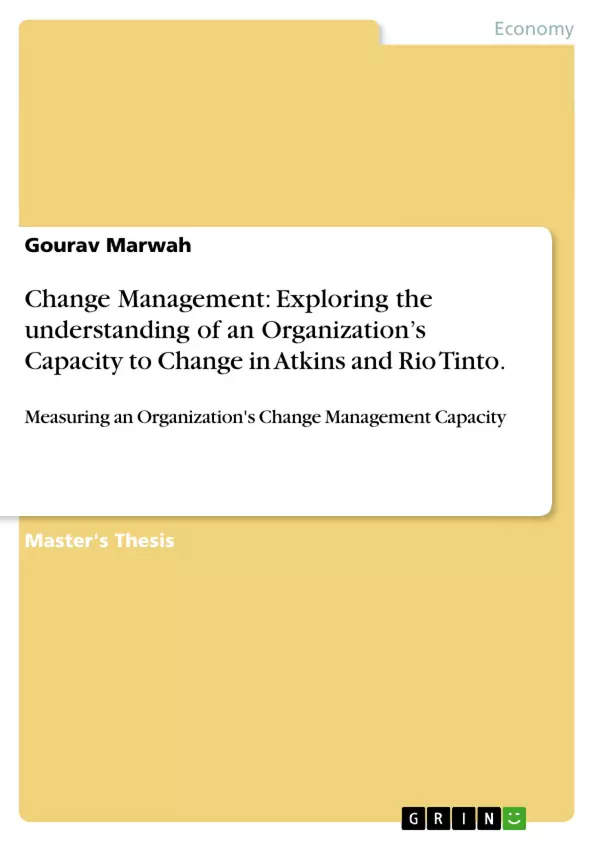The purpose of this report is to detail the background, methodology and the findings of a pilot study that was undertaken to assess what constitutes an organization’s capacity to undergo change.
The study has been sponsored by a boutique management consulting firm based in London, which is looking at new opportunities for its business development. However, the study has far reaching consequences and tries to provide answers to why some organizations are better at change, while others are not.
In-spite of all research and models, 70% of all change initiatives fail to deliver as planned originally. This might leave one wondering why? Why it is that consulting firms have little or no problem to change while manufacturing companies have huge problems even undertaking minor change initiatives? The organization structure does play a part, but what about an organization’s ability or culture; doesn’t that play a part in this?
This study has tried to find answers to the above questions and has high-lighted 8 dimensions that an organization needs to think of before embarking on a change initiative. The dimensions are related to culture, ability of leaders, capabilities of key persons and effectiveness of organization processes. It has been found that each of these 8 dimensions is important for a change initiative to be successful and the same has been validated by studying a recently concluded change effort at Atkins.
The results of the study have helped us identify the areas of improvement for Atkins, so as to mitigate the pain of change efforts. Our recommendations are around effective processes for communication, skills and training programs for line managers and change champions and framework for change planning.
Inhaltsverzeichnis (Table of Contents)
- Introduction
- Able and How
- Project Brief
- Atkins
- Rio Tinto
- Literature Review
- Change Management
- Organization’s Capacity in Managing Change
- Change Capacity as a Dynamic Capability
- Organization’s Capacity to Change
- Building Blocks of the OCC Construct
- Extending the Concepts of the Construct
- Implications of the Research
- Organizational capacity that enables firms to Change
- Strategic advantage
- Enrich some areas of the Change Kaleidoscope
- Approach and Research Methodology
- Pilot Study
- Research Objective
- Evaluating Options
- Sample Selection
- Design of the Research
- Results
- Analysis of insights of the respondents on the Dimensions
- Trustworthy leadership
- Involved Mid-Management
- Capable Champions
- Systems’ Thinking
- Innovative Culture
- Effective Communication
- Accountable Culture
- Trusting Followers
- Recommendations
- Conclusion
- Limitations of the Study
- Scope for future work
- References
Zielsetzung und Themenschwerpunkte (Objectives and Key Themes)
This report aims to investigate the concept of an organization's capacity to undergo change and examine how this capacity manifests itself in practice. The study, sponsored by a management consulting firm, seeks to identify factors that contribute to organizational change success, particularly within Atkins and Rio Tinto.
- The importance of organizational capacity for change (OCC) as a dynamic capability for successful change initiatives.
- The role of trustworthy leadership and effective communication in driving and supporting change.
- The criticality of a supportive organizational culture that values innovation and fosters accountability.
- The impact of middle management and change champions on the success of change efforts.
- The significance of systems thinking and holistic approaches to change management.
Zusammenfassung der Kapitel (Chapter Summaries)
- Introduction: This section introduces Able and How, the sponsoring consulting firm, and outlines the project brief. It also provides background information on the two case study organizations, Atkins and Rio Tinto.
- Literature Review: This chapter explores the concept of change management and its significance in today's dynamic business environment. It delves into the idea of organizational capacity for change, its theoretical underpinnings, and the components that contribute to this capacity.
- Implications of the Research: This section highlights the potential benefits of the research, including its contribution to a deeper understanding of dynamic capabilities and the development of practical tools for assessing organizational readiness for change.
- Approach and Research Methodology: This chapter details the pilot study methodology used for the research. It outlines the research objective, explains the chosen research strategy, and describes the sample selection and data collection methods.
- Results: This chapter presents the findings from the pilot study, analyzing the survey responses and interview excerpts across the eight dimensions of the OCC construct. The results focus on both Atkins and Rio Tinto, providing insights into the organizational culture, leadership, and communication dynamics.
- Recommendations: Based on the pilot study findings, this chapter offers recommendations for improvement, particularly for Atkins, aimed at enhancing communication, aligning rewards, and developing change champion capabilities.
Schlüsselwörter (Keywords)
This study focuses on organizational capacity for change, dynamic capabilities, change management, leadership, communication, culture, innovation, accountability, systems thinking, Atkins, Rio Tinto, pilot study, and case study.
- Quote paper
- Gourav Marwah (Author), 2011, Change Management: Exploring the understanding of an Organization’s Capacity to Change in Atkins and Rio Tinto., Munich, GRIN Verlag, https://www.grin.com/document/177788



